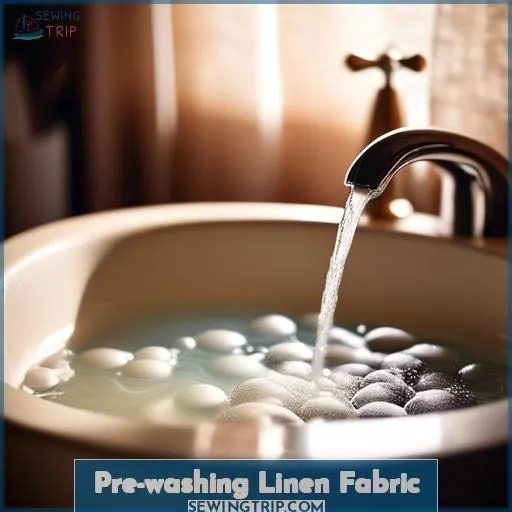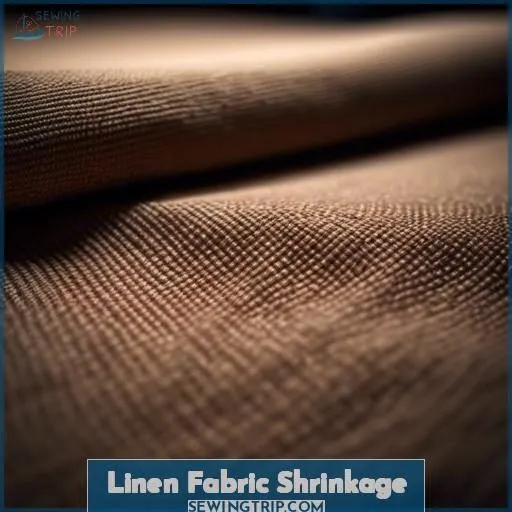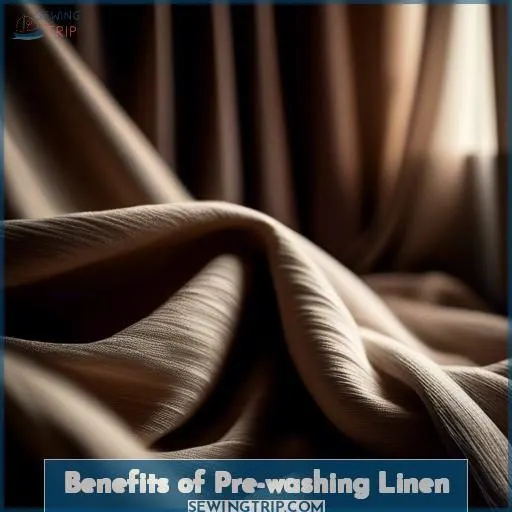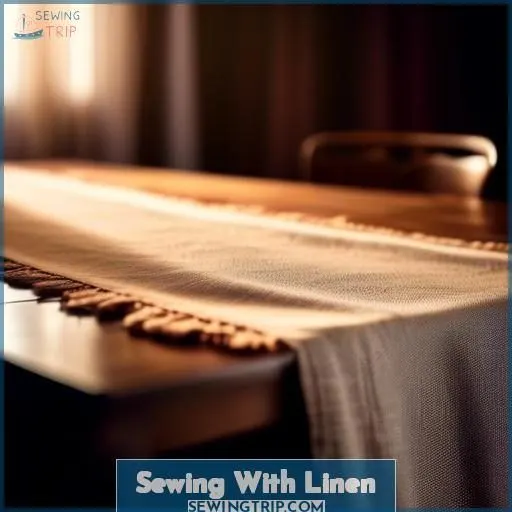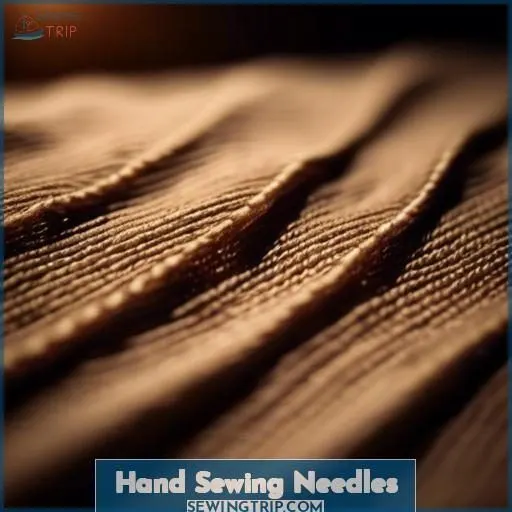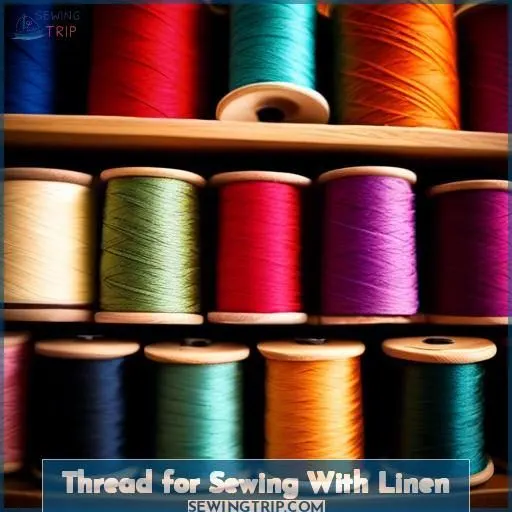This site is supported by our readers. We may earn a commission, at no cost to you, if you purchase through links.
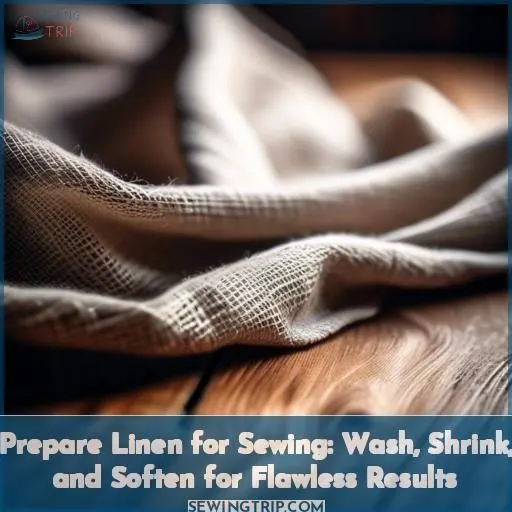
To prepare linen for sewing, you’ll want to pre-wash the fabric to prevent uneven shrinkage and soften the texture.
Soak the linen in cold water for 30 minutes to an hour.
Gently squeeze out excess water.
Hang dry in the shade.
Iron the fabric while slightly damp and stretched to help set the fibers.
Pre-washing also removes impurities and chemical finishes, improving absorbency and preserving the natural color.
For larger yardages, secure raw edges before washing.
Following these steps guarantees your linen is ready for flawless sewing results.
Table Of Contents
- Key Takeaways
- How to Prepare Linen for Sewing?
- Pre-washing Linen Fabric
- Linen Fabric Shrinkage
- Benefits of Pre-washing Linen
- Pre-Washing Large Linen Yardage
- Sewing With Linen
- Why Pre-wash Linen Before Sewing?
- Equipment for Sewing With Linen
- Sewing Machine Needles
- Hand Sewing Needles
- Thread for Sewing With Linen
- Frequently Asked Questions (FAQs)
- Conclusion
Key Takeaways
- Pre-washing linen fabric is essential for minimizing shrinkage and softening the texture.
- Handling linen fabric gently during washing and drying is crucial to prevent distortion and damage.
- Following care instructions provided by the manufacturer is essential for shrinkage prevention and proper fabric care.
- Pre-washing linen fabric removes impurities and chemical finishes, improving absorbency and preserving the natural color.
How to Prepare Linen for Sewing?
To prepare linen for sewing, you should first wash it to remove any dirt or debris.
After washing, you can soften the linen by ironing it on high heat while it’s still damp. Alternatively, you can use a press cloth for delicate pieces.
You can also add white vinegar to the final rinse cycle of your washing machine. Or, sprinkle baking soda in the washing machine before washing.
These methods help loosen the flax fibers in the textile, making it softer and easier to work with.
Pre-washing Linen Fabric
Pre-washing linen fabric is an essential step in preparing it for sewing. By soaking the fabric in cold water for 30 minutes to an hour, you can minimize shrinkage and guarantee a proper fit for your garments. After soaking, gently squeeze out excess water and hang dry in the shadows.
Iron the fabric slightly damp while stretching to eliminate wrinkles. Machine wash on a cool cycle with mild detergent or hand-wash in lukewarm water with gentle detergent. Rinse thoroughly to remove suds and dry the linen as advised by the manufacturer.
Press the fabric while slightly damp to remove wrinkles and enhance fabric absorbency. Pre-washing linen fabric softens the fibers and removes impurities, making it easier to work with and more long-lasting.
Linen Fabric Shrinkage
Linen fabric shrinks due to its natural fibers, which stretch when woven and then relax when washed. This relaxation shrinkage can cause the fabric to return to its original size, potentially leading to distortion and uneven shrinkage. To minimize shrinkage and prevent distortion, follow these steps:
- Pre-wash the fabric: Pre-washing linen before sewing helps to remove impurities, soften the fibers, and minimize shrinkage. Use cold water and a gentle detergent, and avoid high heat settings during drying.
- Avoid high heat: High heat settings during washing and drying can cause linen to shrink more than if the fabric is washed in cold water and dried on a low or medium heat setting.
- Follow care instructions: Always follow the care instructions provided by the manufacturer, as these will guide you on suitable water temperatures, recommended washing methods, and drying instructions to help minimize shrinkage.
- Handle the fabric gently: Avoid wringing or twisting the fabric to remove excess water, as this can cause damage and shrinkage.
Benefits of Pre-washing Linen
Pre-washing linen fabric prevents uneven shrinkage and guarantees a suitable fit when sewing. It also softens the fabric texture and eliminates any impurities or chemical finishes, resulting in a more resilient and long-lasting material.
Shrinkage prevention
To shrink linen fabric, pre-wash it before sewing. Pre-washing minimizes shrinkage, ensuring proper garment fit and making the fabric easier to work with. Uneven shrinkage can be prevented, and the linen fibers are protected from damage.
Use a washing machine on a gentle cycle with cold water and a mild detergent. After washing, press the fabric while slightly damp to remove wrinkles and dry it as recommended. This process improves the fabric’s absorbency and preserves its natural color and texture.
Softening fabric texture
Pre-washing your linen fabric is essential for enhancing its texture and making it more manageable for sewing.
Softening methods encompass submerging in cold water, gentle wringing, and hanging to dry in the shade. Ironing fabric with slight dampness while stretching also assists.
Pre-washing minimizes shrinkage, guaranteeing a proper fit for garments, and mitigates damage to delicate linen fibers, resulting in a more resilient and enduring fabric.
Removing impurities and chemical finishes
Pre-washing linen fabric is a vital step in getting it ready for sewing. This process aids in removing impurities and chemical treatments that can impact the texture and appearance of the fabric. Here are three reasons why pre-washing linen is essential:
- Impurities removal: Pre-washing helps to eliminate dirt, oil, wax, and other substances that might’ve collected on the fabric during manufacturing. This makes sure that these impurities don’t interfere with the dyes and other chemicals used during dyeing and printing.
- Softening the texture: Pre-washing makes the linen fabric softer and more flexible. This is because the washing process breaks down the natural oils and waxes on the fabric, making it easier to handle.
- Improving absorbency: Pre-washing also boosts the absorbency of linen fabric. This is particularly important when working with dyes, as the fabric must be able to absorb the dye evenly to achieve the desired color.
To pre-wash linen fabric, follow these steps:
- Wash in cold water: Soak the linen fabric in cold water for 30 minutes to an hour.
- Rinse with cold water: After soaking, rinse the fabric thoroughly with cold water to remove any suds.
- Dry in the shade: Hang the fabric to dry in the shade to prevent shrinkage and damage to the fibers.
- Iron slightly damp: Iron the fabric while it’s still slightly damp, stretching it as you go to remove any wrinkles.
Pre-Washing Large Linen Yardage
Pre-washing large linen yardage is essential for managing shrinkage and tenderizing the fabric. Hand-washing instructions involve soaking in chilled water, carefully squeezing out excess water, and suspending to dry in the shade.
Pressing should be performed while the fabric is slightly moist and stretched. Specific care considerations include adjusting the iron to a low heat and employing a pressing cloth.
Machine laundering on a gentle cycle with cold water is also possible, but avoid contorting or twisting the fabric. Dryer temperatures should be on the lowest setting, and the fabric should be removed prior to it being entirely dry.
Securing raw edges with a serger or zigzag stitch can prevent unraveling.
Sewing With Linen
Sewing with linen is a delightful experience that combines the strength of the fiber with the versatility of the fabric. Here’s how to sew with linen:
- Choose the Right Pattern: Select a pattern that suits your skill level and the desired outcome.
- Gather Necessary Materials: Linen threads in a similar color to the fabric, cotton thread for seams, and a sewing machine or hand sewing needles.
- Pre-Wash and Prepare: Pre-wash the linen fabric to prevent shrinkage, remove impurities, and make sure it cuts and sews accurately.
- Press Seams and Edges: Press seams and edges before stitching to give a smooth finish.
- Wash Finished Garment: Wash the finished garment on a cool cycle or hand-wash to maintain the linen’s natural color and texture.
Why Pre-wash Linen Before Sewing?
Before you embark on sewing with linen fabric, giving it a pre-wash is like preparing it for a rigorous challenge—it fortifies it for the arduous task ahead. This essential step guarantees your creation won’t dwindle into an undersized garment after its initial exposure to moisture. Moreover, washing softens the linen, rendering it as compliant as a well-disciplined canine. The aim is to prepare the fabric optimally, ensuring your pattern choice and seam allowance calculations aren’t futile endeavors.
| Before Pre-wash | After Pre-wash |
|---|---|
| Linen weight: Unyielding | Linen weight: Supple |
| Thread color: Conjecture | Thread color: Compatible |
| Presser foot: Uncertain | Presser foot: Assured |
Equipment for Sewing With Linen
To guarantee a seamless sewing experience with linen, it’s paramount to select the appropriate equipment. Linen fabric characteristics necessitate specialized tools to address its distinct qualities.
Regarding thread, opt for a premium, robust thread that harmonizes with the fabric. For marking purposes, utilize a water-soluble pen or tailor’s chalk.
For cutting, consider a rotary cutter or scissors. Serging is also indispensable for finishing raw edges, warranting investment in a quality serger.
Needles are a fundamental component, so choose the most suitable ones for your project. By equipping yourself with the right tools, you’ll be able to sew linen with assurance and accuracy.
Sewing Machine Needles
Preparing Linen for Sewing: A Guide to Sewing Machine Needles
When it comes to sewing with linen, selecting the appropriate needle is essential for achieving perfect results. Here’s what you should know:
- Needle types: Employ a universal needle for linen; however, contemplate a ballpoint needle for fabrics that are thicker.
- Point sizes: A size 80/12 or 90/14 is a suitable starting point for most linen endeavors.
- Thread compatibility: Align the thread with the needle size for ideal performance.
- Storage: Keep needles in a container or box to prevent harm and guarantee that they’re readily available.
- Care: Regularly clean and sharpen needles to preserve their efficacy.
Hand Sewing Needles
When working with hand sewing, the right needle can make all the difference. For linen, you’ll want a sharp needle with a large eye to accommodate your thread. Consider needle sizes from 6 to 10, depending on the thickness of your linen.
Needle types include tapestry, embroidery, and lining needles. Keep your needles sharp and store them in a protective case to avoid damage.
Thread for Sewing With Linen
In choosing thread for linen sewing, certain factors warrant attention. Firstly, select a thread weight that corresponds to your linen fabric. A thread that’s disproportionately heavy or light can compromise the aesthetic and tactile qualities of your project. Secondly, contemplate the thread color. While white is a prevalent option for linen projects, you can also explore other hues to align with your personal preferences.
Seek high-grade thread with a smooth surface that resists snagging or fraying when working with linen. To obtain a superior product, consider sourcing thread from a reliable supplier.
Upon washing and drying your linen fabric, you’re ready to commence sewing.
Frequently Asked Questions (FAQs)
How to store linen fabric after pre-washing?
90% of fabric wrinkling happens during storage. After pre-washing, fold linen neatly or roll it onto a cardboard tube – this prevents excessive creasing. Store in a breathable container away from moisture and direct sunlight.
Can linen fabric be dyed after pre-washing?
Yes, you can dye linen after pre-washing. The pre-washing process opens up the fibers, allowing dye to absorb evenly for rich, long-lasting color.
Are there any eco-friendly detergents recommended for linen?
Absolutely, you can opt for eco-friendly detergents like those made from plant-based ingredients or soap nuts. They’ll gently clean your linen without harsh chemicals, keeping it soft and sustainable.
How to handle fraying edges of linen during sewing?
To handle fraying edges when sewing linen, simply finish them with a zig-zag stitch. It’s a quick fix that tames those rambunctious threads, keeping your projects neat and tidy.
What are the best practices for ironing linen garments?
Envision crisp, wrinkle-free linen: iron while damp with a hot iron, mist if needed. Apply firm pressure and stretch the fabric. Iron seams first, then flat sections. Use a press cloth for delicate garments. Regular ironing keeps linen looking fresh.
Conclusion
Properly preparing linen for sewing is like laying a sturdy foundation for a grand structure. You’ll avoid costly mistakes by taking the time to pre-wash, shrink, and soften your linen fabric. Follow these steps to make sure how to prepare linen for sewing results in a beautifully draped, impeccably sewn garment that will stand the test of time.

